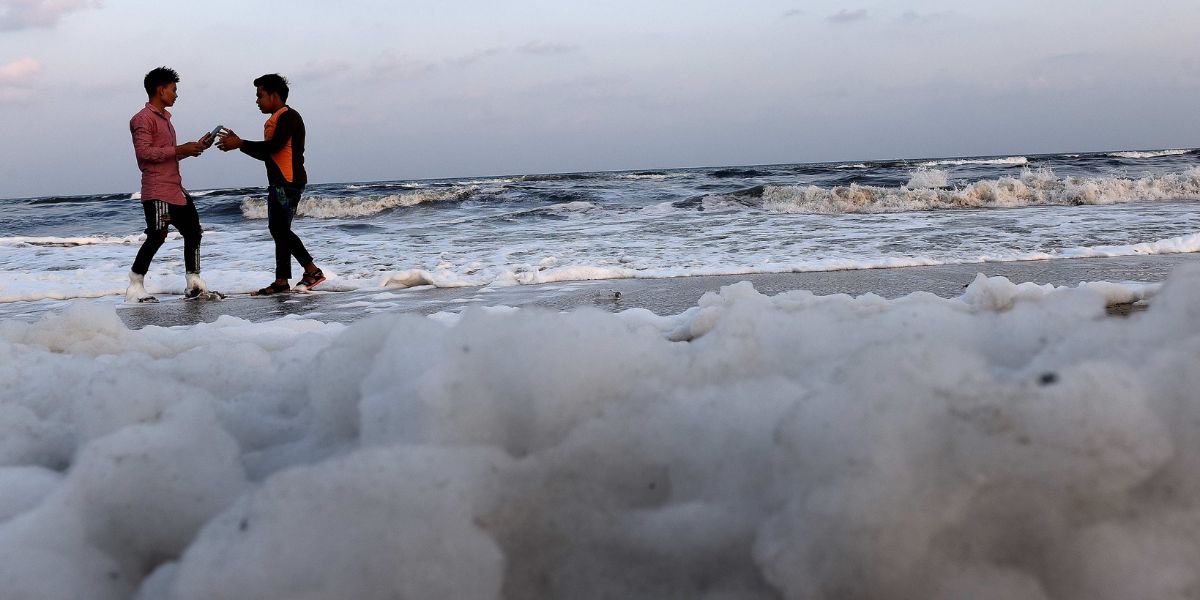Residents and civic activists said the issue reflected long-standing gaps in the treatment of sewage and industrial discharge.
Published Oct 31, 2025 | 12:00 AM ⚊ Updated Oct 31, 2025 | 12:00 AM

File image of froth formation in Marina beach.
Synopsis: Chennai’s Marina Beach turned white with thick foam after a fresh spell of monsoon rain. Experts attributed the froth to the presence of chemical surfactants and phosphates from untreated sewage.
Chennai’s Marina Beach turned white with thick foam after a fresh spell of monsoon rain on Tuesday, 28 October, startling morning walkers and vendors.
The froth, seen along the shore near the Adyar estuary at Pattinambakkam, once again drew attention to the city’s recurring pollution problem that surfaces along the coast during the rainy season. According to civic officials, the foam formed where rainwater from city canals mixed with seawater near the Adyar estuary.
Experts attributed the froth to the presence of chemical surfactants and phosphates from untreated sewage, human waste, and industrial effluents entering the Adyar and Cooum rivers.
Environmental experts have warned that the contamination could harm marine life and affect local livelihoods. Reports indicate that the presence of toxic materials may disrupt breeding cycles and contaminate seafood sources.
Fishermen who depend on the coast are particularly vulnerable to exposure, as the froth-laden water can cause skin irritation and affect daily fishing activities.
The froth formation has once again put the spotlight on Chennai Corporation’s stormwater and canal management. Residents and civic activists said the issue reflected long-standing gaps in the treatment of sewage and industrial discharge.
State BJP leader Vinoj P Selvam criticised the Tamil Nadu government, saying that the situation exposed the reality of civic infrastructure. He said that despite claims of a ₹5,000-crore package for rainwater and storm drainage, even light rain was enough to reveal poor preparedness.
Selvam alleged that the data released by the government on completed works was “bogus” and the numbers “fake”. He demanded a thorough inquiry into the Corporation’s handling of funds and projects once the government changes in 2026.
The incident also drew criticism from environmental advocates, who said stricter monitoring of wastewater discharge and enforcement of treatment protocols were urgently needed.
Dr K Thiruppathi, Head and Senior Consultant, Pulmonology at SIMS Hospital, explained to South First that the foam seen along Marina Beach could contain a mix of hazardous chemicals and microbes formed through natural churning.
“When polluted water is agitated by strong wave action, it produces this thick froth containing both chemical residues and bacteria,” he said, and added that, “These can irritate the skin and eyes and may trigger allergic reactions such as contact dermatitis or burning sensations.”
He mentioned that prolonged or close contact could worsen the irritation. “People who are already allergic can develop severe itching or even a burning type of rash,” Dr Thiruppathi noted and warned that, if exposed, it is best to wash the affected area thoroughly and seek dermatological treatment to prevent infection.
The pulmonologist said the foam could act as a carrier for harmful microbes and pollutants. “It may contain bugs that can lead to infections, including pneumonia, when the exposure is significant,” he explained. “So, both chemical and biological hazards coexist in such foam formations.”
He cautioned that repeated exposure poses deeper health risks over time. “Those working near the sea, such as fishermen, who come into contact with this kind of polluted water for years, may even face carcinogenic risks,” he added.
Speaking about the potential risks, Dr Thiruppathi said even those not directly touching the foam may face hazards from fine aerosolised particles.
“These substances can become airborne and reach the lungs. The lungs are lined by mucous membranes and epithelium that can easily absorb these pollutants,” he explained.
He noted that such exposure could trigger symptoms including cough, wheezing and excessive sputum production. “In people with asthma or chronic lung diseases, it can precipitate bronchospasm, sometimes requiring emergency care,” he added.
The pulmonologist further mentioned that health risks persist even after the visible foam disappears. “Even if the froth is gone in a day or two, the same contaminants may linger in the air or water. People bathing or playing nearby can still be affected,” he said.
His advice to the public was clear: avoid contact with the sea when foam appears, wash thoroughly if exposed, and seek prompt medical attention for any symptoms.
“It is safer to choose cleaner, regulated water sources for recreation,” he urged, adding that “urban coastal pollution has made sea exposure riskier, especially during the monsoon, and caution remains the best protection.”
(Edited by Muhammed Fazil.)
